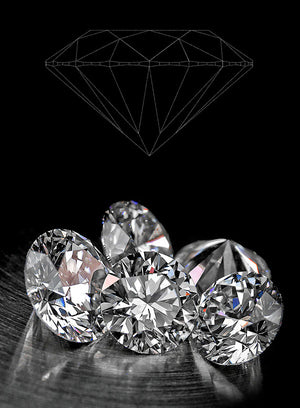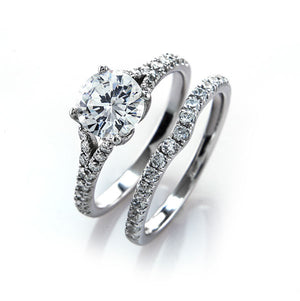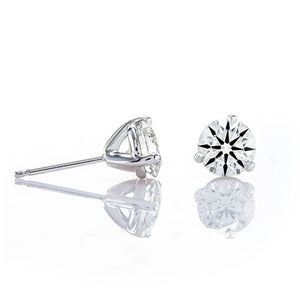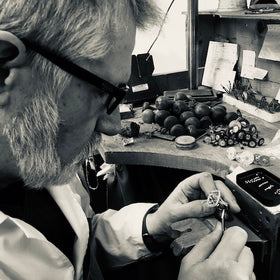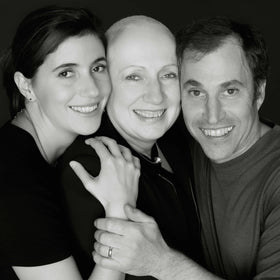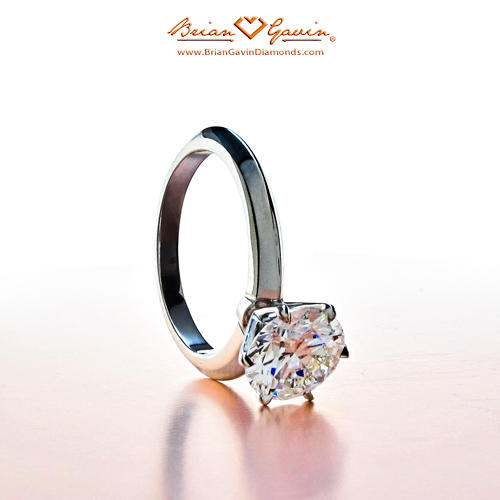
What is a knife edge diamond ring?
"My girlfriend has indicated that she wants a classic knife edge diamond ring, which of course means nothing to me… can you show me what is a knife edge diamond ring and help me find the best round diamond for $20k because this whole diamond ring shopping experience is driving me nuts! I’ve read the diamond grading tutorials provided by Brian Gavin, and they’re great, but at the end of the day I still don’t know what I’m doing! But I’m confident that you can help me choose the largest diamond possible for $20k that will face-up eye clean and be super bright, without my needing to become a diamond expert, something close to two carats would be ideal – no pun intended!”
The classic knife edge style solitaire:
 The classic knife-edge style solitaire from Brian Gavin, which is pictured above, features a six-prong crown that securely holds the diamond in place.
The crown sits on top of a ring shank that is flat on the inside where the ring touches the finger. However, the outer edge of the ring is shaped like a ‘V’ that points outward from the finger. That is why this style of setting is commonly referred to as a knife-edge solitaire.
Although this may be true, the outside edge of the ring shank is not sharp like a knife. As a matter of fact, many people report that this ring style is quite comfortable and that might be why it is so popular.
At the same time, it might take you a few days to get used to wearing the ring. That’s because the “V” shaped edge of a knife-edge solitaire does feel slightly different than the half-round ring shank featured on most rings.
If you look closely at the edge of the classic half-round solitaire pictured on the right and compare it to the ring shank of the ring pictured above, you will be able to distinguish the difference between the two types of ring shanks quite easily. By the way, the prong section of both solitaire style rings is the same. As a matter of fact, that is why these rings look similar at first glance.
At the same time, it might take you a few days to get used to wearing the ring. That’s because the “V” shaped edge of a knife-edge solitaire does feel slightly different than the half-round ring shank featured on most rings.
The classic knife-edge style solitaire from Brian Gavin, which is pictured above, features a six-prong crown that securely holds the diamond in place.
The crown sits on top of a ring shank that is flat on the inside where the ring touches the finger. However, the outer edge of the ring is shaped like a ‘V’ that points outward from the finger. That is why this style of setting is commonly referred to as a knife-edge solitaire.
Although this may be true, the outside edge of the ring shank is not sharp like a knife. As a matter of fact, many people report that this ring style is quite comfortable and that might be why it is so popular.
At the same time, it might take you a few days to get used to wearing the ring. That’s because the “V” shaped edge of a knife-edge solitaire does feel slightly different than the half-round ring shank featured on most rings.
If you look closely at the edge of the classic half-round solitaire pictured on the right and compare it to the ring shank of the ring pictured above, you will be able to distinguish the difference between the two types of ring shanks quite easily. By the way, the prong section of both solitaire style rings is the same. As a matter of fact, that is why these rings look similar at first glance.
At the same time, it might take you a few days to get used to wearing the ring. That’s because the “V” shaped edge of a knife-edge solitaire does feel slightly different than the half-round ring shank featured on most rings.
Best Brian Gavin Signature round diamond for $20k
 I think that the best round diamond for $20k at the moment that will suit your preferences is this 1.758 carat, I-color, VS-2 clarity, Brian Gavin Signature round diamond that exhibits a crisp and complete pattern of hearts and arrows in the diamond.
The diamond has an overall cut grade of AGS Ideal-0 as determined on the Light Performance grading platform of the American Gem Society Laboratory (AGSL) which relies on Angular Spectrum Evaluation Technology (ASET) to determine the brightness of the diamond and provides insight as to how consistent the distribution of light is throughout the diamond.
The proportions of the diamond have been optimized to deliver the highest volume of light return and a virtual balance of brilliance and dispersion, and the sparkle of the diamond will be bold and bright.
Setting this diamond in a white gold or platinum setting will likely improve your perception of the body color of the diamond by about one color grade. In other words, this I-color diamond is likely to face-up closer to H-color when set in white metal prongs. Therefore, it is going to provide you with an eye-clean diamond that is extremely bright and brilliant.
I think that the best round diamond for $20k at the moment that will suit your preferences is this 1.758 carat, I-color, VS-2 clarity, Brian Gavin Signature round diamond that exhibits a crisp and complete pattern of hearts and arrows in the diamond.
The diamond has an overall cut grade of AGS Ideal-0 as determined on the Light Performance grading platform of the American Gem Society Laboratory (AGSL) which relies on Angular Spectrum Evaluation Technology (ASET) to determine the brightness of the diamond and provides insight as to how consistent the distribution of light is throughout the diamond.
The proportions of the diamond have been optimized to deliver the highest volume of light return and a virtual balance of brilliance and dispersion, and the sparkle of the diamond will be bold and bright.
Setting this diamond in a white gold or platinum setting will likely improve your perception of the body color of the diamond by about one color grade. In other words, this I-color diamond is likely to face-up closer to H-color when set in white metal prongs. Therefore, it is going to provide you with an eye-clean diamond that is extremely bright and brilliant.
What Style Knife Edge Ring Setting is Best for Performance?
 One of the most common questions people ask us is whether the ring style is going to affect the performance of a Brian Gavin Signature diamond.
The short answer is “no” because every Brian Gavin Signature diamond is cut to deliver the highest volume of light return and sparkle factor that is vivid and intense.
The style of the setting will have no measurable impact on light performance or sparkle factor. As a matter of fact, our diamonds look spectacular from every angle.
One of the most common questions people ask us is whether the ring style is going to affect the performance of a Brian Gavin Signature diamond.
The short answer is “no” because every Brian Gavin Signature diamond is cut to deliver the highest volume of light return and sparkle factor that is vivid and intense.
The style of the setting will have no measurable impact on light performance or sparkle factor. As a matter of fact, our diamonds look spectacular from every angle.
Contrast Brilliance Makes Diamonds Look Brighter:
As a matter of fact, the reason the arrows pattern appears to be so dark in the photograph of the knife-edge style solitaire above is that the pavilion main facets are reflecting back the dark color of the camera lens. This optical effect is known as contrast brilliance and it is one of the characteristics that makes Brian Gavin Signature diamonds look brighter. The higher degree of optical precision and super ideal proportions produce the highest volume of light return and sparkle factor that is vivid and intense. At the same time, the consistency of facet shape, size, and alignment upon the surface of the diamond create the higher degree of contrast brilliance exhibited by the arrows pattern above. In the first place, the higher degree of contrast brilliance makes the diamond POP because it creates a stronger visual distinction between the different facet sections of a diamond. In addition, the optical effect of light reflecting at different intensities creates the illusion that the diamond is sparkling under lighting situations like fluorescent lighting where diamonds don’t actually sparkle because due to the lack of ultra-violet light.Bezel vs Knife Edge Style Solitaires:
 Now notice how the degree of contrast brilliance exhibited by the arrows pattern of this Brian Gavin Signature diamond is just as vibrant in this bezel setting as it appears to be in the knife-edge solitaire.
Also, notice how the body of the diamond and the sections between the arrows pattern appear to be reflecting light just as evenly. That is because the higher degree of optical precision (consistency of facet structure) ensures that light reflects evenly throughout the diamond. At the same time, the arrows pattern will be less pronounced under normal circumstances because the camera lens will not be directly overhead.
Be that as it may, the higher degree of contrast brilliance created by the higher degree of optical precision will continue to make the diamond sparkle even more because it intensifies the visual effect created by the different facet sections of the diamond.
Now notice how the degree of contrast brilliance exhibited by the arrows pattern of this Brian Gavin Signature diamond is just as vibrant in this bezel setting as it appears to be in the knife-edge solitaire.
Also, notice how the body of the diamond and the sections between the arrows pattern appear to be reflecting light just as evenly. That is because the higher degree of optical precision (consistency of facet structure) ensures that light reflects evenly throughout the diamond. At the same time, the arrows pattern will be less pronounced under normal circumstances because the camera lens will not be directly overhead.
Be that as it may, the higher degree of contrast brilliance created by the higher degree of optical precision will continue to make the diamond sparkle even more because it intensifies the visual effect created by the different facet sections of the diamond.





